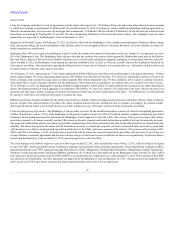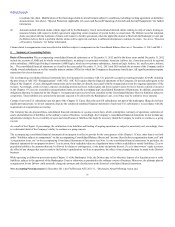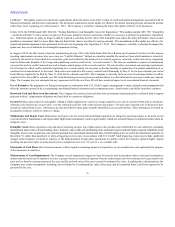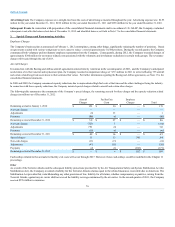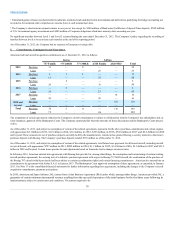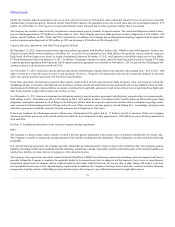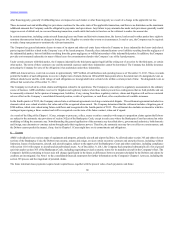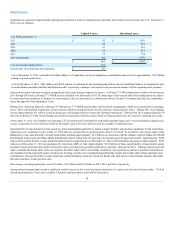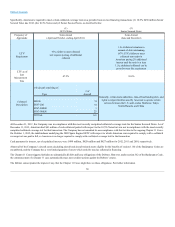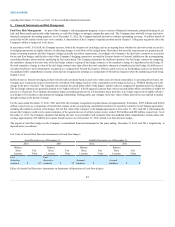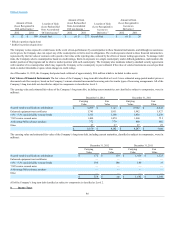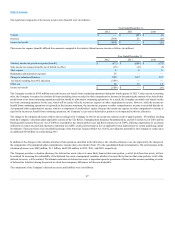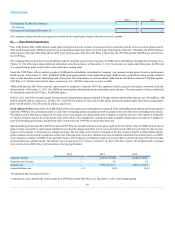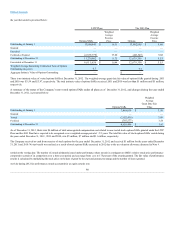American Airlines 2012 Annual Report Download - page 80
Download and view the complete annual report
Please find page 80 of the 2012 American Airlines annual report below. You can navigate through the pages in the report by either clicking on the pages listed below, or by using the keyword search tool below to find specific information within the annual report.
Table of Contents
other financing party, generally if withholding taxes are imposed on such lender or other financing party as a result of a change in the applicable tax law.
These increased cost and withholding tax provisions continue for the entire term of the applicable transaction, and there is no limitation on the maximum
additional amounts the Company could be obligated to pay under such provisions. Any failure to pay amounts due under such provisions generally would
trigger an event of default and, in a secured financing transaction, would entitle the lender to foreclose on the collateral to realize the amount due.
In certain transactions, including certain aircraft financing leases and loans and derivative transactions, the lessors, lenders and/or other parties have rights to
terminate the transaction based on changes in foreign tax law, illegality or certain other events or circumstances. In such a case, the Company may be required
to make a lump sum payment to terminate the relevant transaction.
The Company has general indemnity clauses in many of its airport and other real estate leases where the Company as lessee indemnifies the lessor (and related
parties) against liabilities related to the Company’s use of the leased property. Generally, these indemnifications cover liabilities resulting from the negligence of
the indemnified parties, but not liabilities resulting from the gross negligence or willful misconduct of the indemnified parties. In addition, the Company
provides environmental indemnities in many of these leases for contamination related to the Company’s use of the leased property.
Under certain contracts with third parties, the Company indemnifies the third party against legal liability arising out of an action by the third party, or certain
other parties. The terms of these contracts vary and the potential exposure under these indemnities cannot be determined. The Company has liability insurance
protecting the Company for some of the obligations it has undertaken under these indemnities.
AMR and American have event risk covenants in approximately $497 million of indebtedness and operating leases as of December 31, 2012. These covenants
permit the holders of such obligations to receive a higher rate of return (between 100 and 600 basis points above the stated rate) if a designated event, as
defined, should occur and the credit ratings of such obligations are downgraded below certain levels within a certain period of time. No designated event, as
defined, had occurred as of December 31, 2012.
The Company is involved in certain claims and litigation related to its operations. The Company is also subject to regulatory assessments in the ordinary
course of business. AMR establishes reserves for litigation and regulatory matters when those matters present loss contingencies that are both probable and can
be reasonably estimated. In the opinion of management, liabilities, if any, arising from these regulatory matters, claims and litigation will not have a material
adverse effect on the Company’s consolidated financial position, results of operations, or cash flows, after consideration of available insurance.
In the fourth quarter of 2012, the Company entered into a settlement agreement resolving a commercial dispute. The settlement agreement includes two
elements which were valued at relative fair value and will be recognized when earned. The Company determined that the settlement includes a litigation gain of
$280 million, which was valued using future cash flows and recognized in the fourth quarter of 2012. The settlement also includes an incentive which is
contingent upon signing a future contract and will be recognized over the term of the future contract, when and if signed.
As a result of the filing of the Chapter 11 Cases, attempts to prosecute, collect, secure or enforce remedies with respect to prepetition claims against the Debtors
are subject to the automatic stay provisions of section 362(a) of the Bankruptcy Code, except in such cases where the Bankruptcy Court has entered an order
modifying or lifting the automatic stay. Notwithstanding the general application of the automatic stay described above, governmental authorities, both domestic
and foreign, may determine to continue actions brought under their regulatory powers. Therefore, the automatic stay may have no effect on certain matters, and
the Debtors cannot predict the impact, if any, that its Chapter 11 Cases might have on its commitments and obligations.
6. Leases
AMR’s subsidiaries lease various types of equipment and property, primarily aircraft and airport facilities. As allowed under section 365 and other relevant
sections of the Bankruptcy Code, the Debtors may assume, assume and assign, or reject certain executory contracts and unexpired leases, including, without
limitation, leases of real property, aircraft, and aircraft engines, subject to the approval of the Bankruptcy Court and other conditions, including compliance
with section 1110 with respect to aircraft and aircraft-related assets. As of December 31, 2012, the Company had completed substantially all of its expected
activities under section 365 of the Bankruptcy Code, including negotiating revised economic terms for its mainline aircraft in the Company's fleet. The
Company's liabilities pertaining to leases may still change significantly in the future as differences between amounts scheduled by the Debtors and claims by
creditors are investigated. See Note 1 to the consolidated financial statements for further information on the Company's Chapter 11 process, including the
section 365 process and the magnitude of potential claims.
The future minimum lease payments required under capital leases, together with the present value of such payments, and future
80


